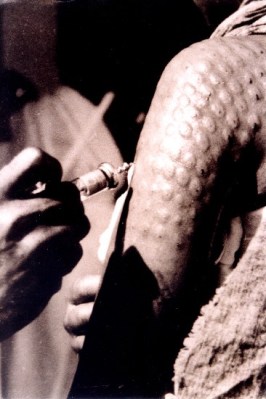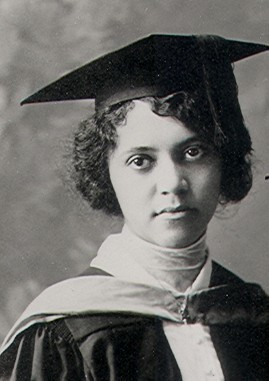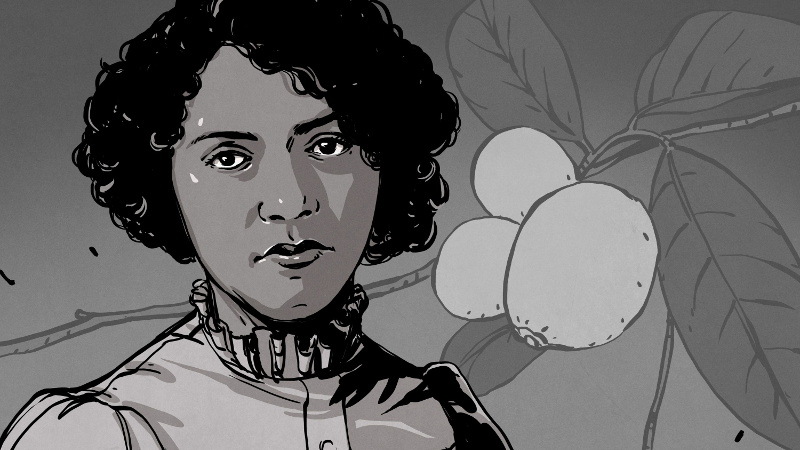Leprosy is a bacterial disease that affects the skin, nerves, eyes, and mucosal surfaces of the upper respiratory tract. It is transmitted via droplets and causes skin lesions and loss of sensation in these regions. Also known as Hansen’s disease after the 19th century scientist who discovered its bacterial origin, leprosy has been around since ancient times, and those afflicted have been stigmatized and outcast for just as long. For years, people were sent to live the rest of their days in leper colonies to avoid infecting others.

Until Alice Ball came along, the only thing that could be done for leprosy — injecting oil from the seeds of an Eastern evergreen tree — didn’t really do all that much to help. Eastern medicine has been using oil from the chaulmoogra tree since the 1300s to treat various maladies, including leprosy.
The problem is that although it somewhat effective, chaulmoogra oil is difficult to get it into the body. Ingesting it makes most people vomit. The stuff is too sticky to be applied topically to the skin, and injecting it causes the oil to clump in abscesses that make the patients’ skin look like bubble wrap.
In 1866, the Hawaiian government passed a law to quarantine people living with leprosy on the tiny island of Moloka’i. Every so often, a ferry left for the island and delivered these people to their eventual death. Most patients don’t die of leprosy, but from secondary infection or disease. By 1915, there were 1,100 people living on Moloka’i from all over the United States, and they were running out of room. Something had to be done.
Professor Alice Ball hacked the chemistry of chaulmoogra oil and made it less viscous so it could be easily injected. As a result, it was much more effective and remained the ideal treatment until the 1940s when sulfate antibiotics were discovered. So why haven’t you heard of Alice before? She died before she could publish her work, and then it was stolen by the president of her university. Now, over a century later, Alice is starting to get the recognition she deserves.

Surrounded By Chemistry
Alice August Ball was born July 24th, 1892 in Seattle, Washington. She was one of four children, with two older brothers and a younger sister. Alice’s family was middle class — her father was a newspaper editor, lawyer, and photographer. Her mother was a photographer. And her grandfather, James Presley Ball, was a famous photographer who was among the first Black Americans to use the daguerreotype method — printing photographs on metal plates instead of paper. This was the first publicly-available printing process and it involved iodine-sensitized silver plates and mercury vapors, so Alice was surrounded by chemistry from a young age.
When Alice was still a child, the family moved to Hawaii in an attempt to soothe Grandpa Ball’s arthritis with heat. He died soon after they arrived, and the family moved back to Seattle about a year later. Alice attended Seattle High School until 1910, earning high grades in all the sciences. Then she earned two bachelor’s degrees from the University of Washington by 1914 — one in pharmaceutical chemistry, and the other in the science of pharmacy.
Alice was offered several scholarships for graduate school and settled on the University of Hawaii. She received a master’s of chemistry and stayed on as a professor. Part of her master’s thesis included a study of the Kava plant species and its chemical properties. Her work drew the attention of Dr. Harry T. Hollmann, who recruited Alice to study chaulmoogra oil and to assist him in treating leprosy patients at Kalihi Hospital when she wasn’t teaching.
The Ball Method
Alice and Dr. Hollmann had been heating the chaulmoogra oil, but she realized that was the wrong approach and tried freezing the extract instead after exposing the fatty acids in the oil to alcohol. In doing this, Alice came up with a method to isolate the ester compounds from the oil and modified them to produce a substance that could be better absorbed by the body while keeping the medicinal value intact.

The Ball Method worked quite well. Within a few years, nearly 100 people who had received the intravenous chaulmoogra oil treatment had no more lesions and were allowed to return home to their families. It was so successful that for a few years, no new patients were exiled to Moloka’i. Chaulmoogra oil continued to be used until the 1940s when sulfonamide antibiotics were invented.
Unfortunately, Alice died December 31st, 1916 before she had a chance to publish her work. Though her death certificate lists ‘tuberculosis’, the cause is arguably unknown. It was reported that she was accidentally exposed to chlorine gas while giving a demonstration about proper gas mask usage.
The college’s president, Arthur Dean, picked up where Alice left off and then co-authored a paper in 1920 claiming it as his own without any credit to Alice. Dr. Hollmann published his own paper two years later giving Alice the credit she deserved, and admonishing Dean for having the audacity to add absolutely nothing to Alice’s work and then pass it off as his own.
In the 1930s, the King of Siam (now Thailand) sent a chaulmoogra tree to the University of Hawaii as a thank you gift. A plaque was affixed there on February 29th, 2000 in a ceremony that was attended by several former inhabitants of Moloka’i. That day, the lieutenant governor of Hawaii declared it would be henceforth known as Alice Ball Day and be celebrated every four years. Historians have worked since the 1970s to restore Alice Ball’s legacy, and we think it’s an important one worth immortalizing.

















Yep, this sort of thing keeps happening. Also see Antonio Meucci because he was an immigrant.
“If you become an inventor, you can make someone else very, very rich!” doesn’t sound very motivational when you say it to students in history class…
If you have known many “inventors”, this is not unexpected. They tend to either claim they have been cheated, or they take their secret inventions to the grave due to fears of being cheated and not getting credit! I have seen it several times.
Thankfully we now have open source. You can’t be cheated if you give it away.
until a company decides to use whatever it is and just happen to forget its open source under a license, that would never happen, espeically when that company provides a good or service that makes them millions
Behringer?
That’s basically saying you can’t be cheated if you cheat yourself out of reimbursement for the work you’ve put in.
That’s like saying you can’t be a victim of revenge porn if you post your your nudes yourself.
Inventors deserve to be paid for what they develop. That’s what the parent system was intended for, though it’s overdue a revamp to make it fit for purpose again.
They do. But since, naturally, what they invented contributed to the public good, they should be paid by the public, from taxes. They might never strike it rich but their gainful employment is not incompatible with destroying patent law.
Information is fundamentally different from every other thing, in that the cost of giving it to somebody else is significantly lower than the cost of creating it. That’s special and we shouldn’t be fighting against it.
I don’t think most inventors do it, with thoughts of getting rich. They see a need for something useful, and a personal challenge to make it work. It’s usually someone else who see the work, and the dollar signs.
A couple years ago, Seattle named a recently-built park after Alice Ball: https://www.seattle.gov/parks/find/parks/alice-ball-park
Was cool to learn about her work on a neighborhood walk, and then get some more details here. Thanks for the profile!
There are still lepers on the molokai colony. They all will stay until death. The colony is maintained by the govt. A harrowing donkey trip down a steep cliff enables a visit, but you will not see any lepers…
btw, what else is new? My thesis advisor patented some of my thesis work. Nowhere near as important as Ms. Ball’s but wtf?
I have heard your story a hundred times. Always college age.
Just a an idea, encourage people to use those patents and when they are challenged in court they can use your thesis as prior art? ¯\_(ツ)_/¯ Just throwing stuff on the wall.
In college I had a class on Android development and at the end of the semester each group of students produced an app.
A few years after graduating I discovered my professor had taken our apps on the road, one some awards for them, and sold some of them off to various companies. None of the students were credits and all the money went to him personally.
Academia is messed up.
academia will be the next target of ransomeware
I really don’t see how the personal moral/ethical failings of your college professor add up to so broad a generalization as “Academia is messed up”. Better to acknowledge the failings of humans in general.
I think they are ex-lepers now.
Like in Monty Python’s Life of Brian https://www.youtube.com/watch?v=U74s8nFE7No
Apparently they chose to stay, I guess they had nowhere else to go.
Shame she died so young, she probably had much more to contribute.
What an outstanding human. Damn shame how she was treated. Kudos to the author of this article. Too often these articles reek of pandering, but this focused on the person, the science, and the facts.
The world needs more people like Alice Ball!
“Dr. Hollmann published his own paper two years later giving Alice the credit she deserved, and admonishing Dean for having the audacity to add absolutely nothing to Alice’s work and then pass it off as his own.”
The world needs more people like Dr. Hollmann too, both in terms of encouraging up and coming students and professionals and in terms of being open and honest. It’s critically important that others in academia openly acknowledge those who deserve the credit and publicly criticize those who take credit where none is due.
I think you mean “sulfa” antibiotics, short for sulfonamide, not “sulfate” which is more of a chemical term rather than a class of antimicrobials.
Other than that small typo (sorry for pointing it out, I’m a chemist who did a lot of drug design work), great article and always good to see these.
Thanks again
Something else about leprosy, it’s not contagious to everyone, only a select few with certain genetic defect, IIRC. A horrible disease but not as scary as it could have been for sure.